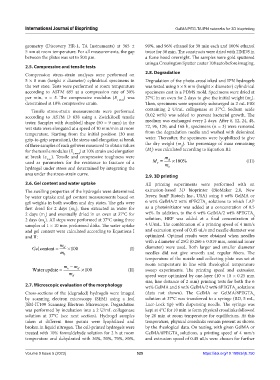Page 533 - IJB-9-5
P. 533
International Journal of Bioprinting GelMA/PEG-TA IPN networks for 3D bioprinting
geometry (Discovery HR-1, TA Instruments) at 365 ± 90%, and 96% ethanol for 30 min each and 100% ethanol
5 nm at room temperature. For all measurements, the gap twice for 30 min. The constructs were dried with HMDS in
between the plates was set to 500 µm. a fume hood overnight. The samples were gold sputtered
using a Cressington Sputter coater 108 auto before imaging.
2.5. Compressive and tensile tests
Compression stress-strain analyses were performed on 2.8. Degradation
5 × 8 mm (height × diameter) cylindrical specimens in Degradation of the photo-crosslinked and IPN hydrogels
the wet state. Tests were performed at room temperature was tested using 5 × 8 mm (height × diameter) cylindrical
according to ASTM 695 at a compression rate of 30% specimens cast in a PDMS mold. Specimens were dried at
per min, n = 5. The compressive modulus (E c-mod ) was 37°C in an oven for 2 days to give the initial weight (m ).
0
determined at 10% compressive strain. Then, specimens were separately submerged in 2 mL PBS
Tensile stress-strain measurements were performed containing 2 U/mL collagenase at 37°C. Sodium azide
according to ASTM D 638 using a ZwickRoell tensile (0.02 wt%) was added to prevent bacterial growth. The
tester. Samples with dumbbell shape (50 × 9 mm) in the medium was exchanged every 2 days. After 6, 12, 24, 48,
wet state were elongated at a speed of 10 mm/min at room 72, 96, 120, and 168 h, specimens (n = 3) were removed
temperature. Starting from the initial position (30 mm from the degradation media and washed with deionized
grip-to-grip separation), the stress and elongation at break water. Thereafter, the specimens were lyophilized to give
of three samples of each gel were measured to obtain values the dry weight (m ). The percentage of mass remaining
d
for the tensile modulus (E t-mod ) at 10% strain and elongation (M ) was calculated according to Equation III:
r
at break ( max ). Tensile and compressive toughness were m d
used as parameters for the resistance to fracture of a M = m ×100% (III)
r
hydrogel under stress and determined by integrating the o
area under the stress-strain curve. 2.9. 3D printing
2.6. Gel content and water uptake All printing experiments were performed with an
The swelling properties of the hydrogels were determined extrusion-based 3D bioprinter (BioMaker 2.0, New
by water uptake and gel content measurements based on Jersey, SunP Biotech Inc., USA) using 6 wt% GelMA or
gel weights in both swollen and dry states. The gels were 6 wt% GelMA/2 wt% 8PEGTA solutions to which LAP
5
first dried for 2 days (m ), then extracted in water for as a photoinitiator was added at a concentration of 0.5
0
2 days (m ) and eventually dried in an oven at 37°C for wt%. In addition, to the 6 wt% GelMA/2 wt% 8PEGTA
5
s
2 days (m ). All steps were performed at 37°C using three solution, HRP was added at a final concentration of
d
samples of 1 × 10 mm preformed disks. The water uptake 4 U/mL. The combination of a printing speed of 4 mm/s
and gel content were calculated according to Equations I and extrusion speed of 0.45 uL/s and needle diameter was
and II: optimized. Optimal results were obtained when needles
with a diameter of 25G (0.260 ± 0.019 mm, nominal inner
m diameter) were used. Both larger and smaller diameter
Gelcontent = d ×100 (I)
m needles did not give smooth and regular fibers. The
0
temperature of the nozzle and collecting plate was set at
m − m room temperature in line with rheological temperature
Water update = s d ×100 (II) sweep experiments. The printing speed and extrusion
m d speed were optimized by one-layer (10 × 10 × 0.25 mm
size, line distance of 2 mm) printing tests for both the 6
2.7. Microscopic evaluation of the morphology wt% GelMA and 6 wt% GelMA/2 wt% 8PEGTA solutions
5
Cross-sections of the (degraded) hydrogels were imaged (data not shown). The GelMA or GelMA/8PEGTA
5
by scanning electron microscopy (SEM) using a Jeol solution at 37°C was transferred to a syringe (BD, 5 mL,
JSM-IT100 Scanning Electron Microscope. Degradation Luer-Lock tip) with dispensing needle. The syringe was
was performed by incubation into a 2 U/mL collagenase kept at 4°C for 10 min to form physical crosslinks followed
solution at 37°C (see next section). Hydrogel samples by 20 min at room temperature for equilibrium. At this
taken at different time points were lyophilized and temperature, physical crosslinks remain present as shown
broken in liquid nitrogen. The cell-printed hydrogels were by the rheological data. On testing, with given GelMA or
treated with 10% formaldehyde solution for 2 h at room GelMA/8PEGTA solutions, a printing speed of 4 mm/s
5
temperature and dehydrated with 30%, 50%, 70%, 80%, and extrusion speed of 0.45 uL/s were chosen for further
Volume 9 Issue 5 (2023) 525 https://doi.org/10.18063/ijb.750

